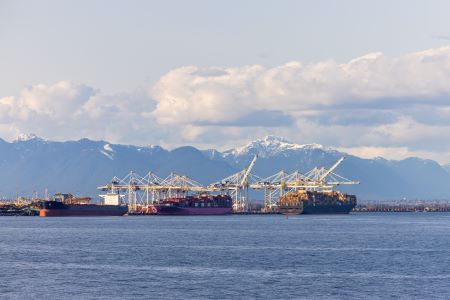Ottawa should quickly approve nation-building projects as part of a new “Mission Canada” policy framework


The federal government needs to identify and deliver on a list of high-impact, “no regrets,” nation-building projects to attract investment and increase Canada’s productivity, according to a new report by the Public Policy Forum (PPF).
Impact assessment and permitting processes should be completed within two years and, if the clock runs out, these projects should be deemed approved, the report says.
PPF calls the report a “Mission Canada” plan and a playbook – with 10 essential plays – for turbocharging investment in major energy, critical minerals and infrastructure projects.
“This crucial moment for Canada is beset by daunting challenges, but also ripe with enormous opportunity,” the report says.
Realizing the opportunity will demand coordinated public and private sector action to unlock investment and advance high-impact projects, prioritizing new developments that will supercharge the economy by getting Canada’s energy and critical minerals resources to the global market and delivering reliable, affordable, low-carbon energy to meet domestic demand and decarbonize the country’s energy systems, the report says.

 The report was written by Jay Khosla (photo at right), former assistant deputy minister in the Privy Council Office; Yiota Kokkinos (photo at left) former director general at Natural Resources Canada; and Chris Turner (photo at left below), an author, essayist and energy policy strategist.
The report was written by Jay Khosla (photo at right), former assistant deputy minister in the Privy Council Office; Yiota Kokkinos (photo at left) former director general at Natural Resources Canada; and Chris Turner (photo at left below), an author, essayist and energy policy strategist.
The authors looked at the economic potential of the current inventory of resource projects already proposed or underway across Canada.
 Working with Navius Research, they modelled the latest data from Natural Resources Canada’s Major Projects Inventory, tracking more than 500 natural resource projects that are either already under construction or planned through 2034.
Working with Navius Research, they modelled the latest data from Natural Resources Canada’s Major Projects Inventory, tracking more than 500 natural resource projects that are either already under construction or planned through 2034.
All told, these projects – spanning clean electricity, oil and natural gas, mining and clean technologies –represent over $600 billion in potential capital investment.
Navius’s analysis found that advancing these existing projects to FID (final investment decision) could generate up to $1.1 trillion in cumulative GDP growth, representing a roughly 4.5-percent increase in Canada’s GDP by 2035.
“This alone would deliver a transformative boost to Canada’s economy, turning energy, critical minerals and infrastructure into engines of long-term growth and propelling Canada’s efforts to become a global powerhouse in energy and critical minerals, including a leader in the low-carbon global economy,” the report says.
However, a diverse group of experts and stakeholders the authors consulted identified significant weaknesses in Canada’s current “game plan,” as well as barriers to success that include:
- burdensome regulatory processes and permitting procedures.
- insufficient financial supports and difficulty accessing capital, particularly in the crucial, high-risk development stages before getting to FID.
- inadequate infrastructure such as roads, bridges and ports.
- a persistent lack of capacity and capital among Indigenous groups to participate fully as partners in new projects.
Those people consulted pointed to a maze of overlapping government departments, assessments and permitting authorities that can lead to spending more than $1 billion on a large project before it even reaches that all-important FID – and, even then, sometimes only to be cancelled due to shifting political currents.
Even though provinces and territories with their diverse energy mixes and needs remain the primary arbiters on crucial questions of permitting, investment and Indigenous participation, projects related to energy, mining and infrastructure in Canada spend three to six years on average in federal regulatory review processes alone, the report notes.
“This pace is costing Canadians and frustrating the achievement of their economic and energy needs.”
Long-term prosperity depends not only on unlocking Canada’s vast natural resource potential, but also on building the infrastructure that connects the regions and gets the country’s products to market efficiently, the report says.
Prioritizing nation-building projects such as ports, rail and roads is essential to strengthening internal economic linkages, enhancing export competitiveness and ensuring supply chains remain resilient and globally competitive.
“Without modern and reliable trade infrastructure, even the most promising energy and resource projects will struggle to deliver their full economic value,” the report says.
Build a new policy framework on four strategic pillars
The report’s authors say a new policy framework should be built on four strategic pillars:
- Co-ordinated financing: Align public and private funding sources to support priority projects and close investment gaps.
A realignment and co-ordination of policies and agencies between levels of government (federal, provincial/territorial and sometimes municipal) and within each level of government is urgently needed, the report says.
The “alphabet soup” of institutions and programs – particularly at the federal level – needs to be streamlined to provide a “one-stop shop” approach for federal financial support.
The most effective role for public financing is often in de-risking projects, particularly in the lengthy, high-risk early phases of a large, long-term project’s path to FID. This includes support for home-grown innovation, first-of-its-kind deployment, or scaling up new technology.
While the market should take the lead in driving investment and supplying private capital for major resource projects, governments have a vital role to play in bridging financing gaps.
The United Kingdom’s National Policy Statements provide a strong example of how to guide major infrastructure development, outlining national needs and assessment frameworks through statements that are regularly updated and subject to public scrutiny, according to the report.
- Efficient and effective regulations: Reconfigure regulatory and permitting processes to get to “yes” much more quickly, providing clearer timelines, improved efficiency and effectiveness, greater certainty, enhanced environmental performance, and a more strategic role for economic regulators across jurisdictions.
Project proponents and government regulators alike must navigate a complex, overlapping and often confusing set of regulations and applications to get projects to FID, the report says.
For large, long-term projects, the approval timeline often stretches across election cycles – a new mining project in Canada, for example, can take anywhere from 15 years to 25 years from application to production.
This leaves projects vulnerable to changing political priorities and further amplifies risk for investors, according to the report.
As well, many of the existing regulations are not fit for purpose: they were designed to maintain current energy systems and infrastructure, not for Canada’s upcoming rapid growth and new technology deployment to integrate clean energy sources and reduce emissions.
The European Union’s Projects of Common Interest initiative offers a possible model for multi-jurisdiction regulation, as it provides strong support for key cross-border energy infrastructure (especially electricity transmission) that benefits multiple member states.
- Enabling critical infrastructure: Take a systems-level approach to planning to ensure that foundational infrastructure and skilled labour are in place to support future growth.
Canada has accumulated a significant deficit in critical infrastructure of all kinds – a report by BCG estimated 30 percent to 50 percent of Canadian infrastructure now requires or will soon need major maintenance work or replacement.
Canada’s infrastructure investments since 1990 have hovered around the average of its Organisation for Economic Co-operation and Development peers, but spending on transport, energy and utilities has lagged below that average.
Government support should include regulatory interventions – perhaps similar to those brought in by the state of Texas, where coordinated electricity transmission planning and permitting to facilitate the construction of necessary transmission lines have enabled the rapid development of wind power across the state, the report says.
- Increasing Indigenous economic participation: Strengthen partnerships between project proponents, government institutions and Indigenous rights-holders to support meaningful Indigenous involvement in major projects, including through improved access to capital, stronger ownership opportunities and continuous capacity building.
The path to advancing major energy, mining and infrastructure projects in Canada increasingly runs through meaningful partnerships with Indigenous communities and rights-holders. “While each project is unique, early engagement and opportunities for economic participation and equity partnerships are essential.”
The Duty to Consult and Accommodate defines a relationship between the Crown and Indigenous rights-holders, and the federal government is responsible for discharging this duty.
Yet the current consultation process is often opaque, confusing and poorly communicated – creating uncertainty for both project proponents and Indigenous rights-holders, the report notes. This leaves both groups uncertain how to proceed and lacking in clarity regarding when the duty has been met.
To be meaningful, Indigenous participation must go far beyond the consultation process. An effective way to ensure that a project’s real, material benefits extend fully to Indigenous groups is to prioritize economic participation and equity partnerships.
The B.C. government’s fast-tracking of energy projects with a minimum of 25-percent Indigenous equity participation (with at least eight of the projects securing 51-percent equity participation) demonstrates the effectiveness of this strategy, the report’s authors say.
Reliable access to affordable capital to participate in the financing of new projects, as a recent RBC report noted, remains “a persistent challenge for members of Indigenous communities, caused in part by institutional barriers set up by Canadian governments.”
Current financing tools still leave a capital gap of nearly $50 billion between Indigenous access and potential project needs, putting up to 85 percent of projects passing through First Nations territory at risk.
Ten essential “plays” are required to unlock Canada’s full potential
The report’s authors say governments need to make 10 essential “plays” to align public and private sector action, accelerate nation-building and unlock Canada’s full potential:
- Accelerate economic growth through a united vision:
- Implement a national game plan to spur economic growth and align public and private sector action to get nation-building projects built more quickly and to turbocharge Canada’s economy.
- Strike a first ministers meeting to discuss Canada’s growth and investment trajectory, including launching a process to develop a priority list of energy, critical minerals and enabling infrastructure projects.
- Commit to adopting a federal/provincial/territorial system-wide approach to advance the four interrelated strategic pillars and policy levers in an integrated manner. The goal for first ministers should be to identify efficiencies and synergies that will expedite the policy and legislative changes needed to move projects forward.
- All levels of government must formally affirm that “Canada is open for business,” backed by concrete actions that will make Canada a globally competitive destination for major project investment and development.
- The federal government should organize Team Canada missions to Asia, Europe and other potential markets, bringing together other levels of government, industry and Indigenous Peoples to promote Canada’s economic opportunities and competitive advantages.
- The federal government should send a clear message in its policies and communications that Canada is prioritizing infrastructure, energy and critical minerals development – and that it is ready to partner with industry and governments to attract investment.
- Establish a clear national objective for Canada to achieve real GDP per capita growth rates that place us firmly in the top 50 percent of OECD countries, strengthening Canada’s global competitiveness and prosperity.
- Set a national goal for Canada to be in the top 10 of the World Bank’s ease-of-doing-business rankings within two years and to reach the top five within five years.
- Declare a “no-regrets” projects list:
- Create a national list of major projects deemed “no regrets.” These should be nation-building projects that respect regional and provincial differences and are aligned with criteria that should include prosperity, security, environmental responsibility and reconciliation.
- Complete impact assessment and permitting processes within two years. If the clock runs out, these projects should be deemed approved. While this could be achieved through strong leadership and governance within existing legislation, changes to Bill C-69 and affiliated permitting legislation may need to be considered.
- Ensure the critical infrastructure needed to enable energy and critical minerals projects is included in this list.
- Table the list at an initial first ministers meeting on investment and economic growth.
- Launch a strategic investment office:
- Integrate the four strategic pillars by consolidating financing, regulatory, enabling critical infrastructure and Indigenous consultation functions into a single cohesive office. This will promote a system-wide approach, ensuring coherence in both government policy and funding.
- Unite under one mission to accelerate the approval of “no-regrets” projects within a two-year window.
- House the office within a central agency led by a deputy minister and build it mostly with existing resources.
- Maintain accountability to a cabinet committee on investment, chaired by the prime minister, that provides cabinet approvals and oversees progress.
- Assign one project team per “no-regrets” project. Staff the teams with experts in financial advisory, resource project planning and development, regulatory and permitting processes, emissions reductions and Indigenous consultation, who are brought in from across the federal government, provinces and territories.
- Leverage the Agile Project Management approach. Enable rapid adaptation, continuous iteration and accelerated decision-making.
- Coordinate and direct the “no-regrets” projects, including connecting with all the levers and funding envelopes across government to create packaged financing for each project; lead “one project, one assessment” (if not delegated to a province or territory); and coordinate the permitting approval requirements and Indigenous consultations to enable getting projects to FID faster.
- Create a single window for project proponents to submit proposals, including Indigenous consultations. This is needed because Indigenous groups and industry officials remain confused as to which federal funding agency to engage, as these agencies distinguish between greenfield and brownfield projects.
- Designate a single Crown consultation coordinator for each “no-regrets” project to ensure efficiency of process, effective policy coherence and consistent practices across the federal system.
- Get the biggest bang for taxpayer financing:
- Governments can play a vital role in bridging financing gaps to accelerate the path to FID while the market remains the primary driver of investment and source of private capital.
- Create a single window for proponents to access federal project financing, advisory support and funding tools.
- Attract and unlock capital. Governments should consider backstopping the “no-regrets” projects to provide financial risk insurance that will attract capital. Consider innovative approaches to financing, including crowding in institutional capital and foreign capital.
- Consider tax measures in the optimization of the overall policy mix, for example, by: reducing the effective tax rate on new investments and capital gains; allowing a 100-percent exemption on capital gains taxes payable if the proceeds are re-invested into another asset within 12 months; and exempting all profits invested in new capital, machinery and equipment from taxation.
Streamlined and faster regulatory and permitting approvals needed
- Speed up and de-layer regulatory and permitting approvals:
- Provide faster regulatory approvals and permitting. Remove overlap and duplication, while continuing to uphold the highest environmental standards and respecting Indigenous perspectives on the traditional use of air, water and land.
- Implement a “one project, one assessment” approach for all projects. Substitute provincial/territorial/Indigenous environmental assessment processes where possible.
- Create certainty of process. Clearly map out the approvals process up front to provide clarity and build trust and confidence with project proponents (for instance, Ontario Power Generation took this approach for its small modular reactor projects). Once a decision is made to proceed with a project and a permit is issued, the decision should not be overturned.
- Reverse the cumulative regulatory burden to restore Canada’s competitiveness for investment.
- Designate a single Crown consultation coordinator for each “no-regrets” project.
- Ensure regulatory stability, including regarding when changes in government occur.
- Change the legislative mandates for regulatory authorities (e.g., Canada Energy Regulator, Impact Assessment Agency, Transport Canada, Fisheries and Oceans Canada, Environment and Climate Change Canada) to take into account economic and investment factors in the permitting process.
- Advance meaningful opportunities for Indigenous economic participation:
- Governments, industry and regulators need to take a long-term view in building relationships with Indigenous rights-holders and communities to earn trust and confidence;
- Create opportunities for equity ownership. Governments should prioritize projects that have meaningful Indigenous economic support and/or participation and/or partnership (for example, revenue sharing, jobs and procurement, and equity partnership. B.C. required a minimum of 25-percent Indigenous equity for projects to qualify in the 2024 Call for Power). Equity ownership by Indigenous Peoples also needs to be considered across the value chain, including shipping and infrastructure.
- Accelerate access to capital for Indigenous governments and their corporations.
- Enable Indigenous investment in all project stages, including the earliest stages when Indigenous partners have the best opportunity to add value and shape a project’s outcome.
- Provide employment, training and skills development. Develop initiatives to ensure Indigenous individuals and communities are equipped to secure employment related to major project development, including skills development to obtain the Red Seal for trades.
- Increase opportunities for procurement, contracting and business development for Indigenous businesses.
- Align critical enabling infrastructure (physical structures and people):
- Prioritize and rank critical infrastructure projects.
- Pursue an integrated federal-provincial-territorial (F/P/T) approach. F/P/T collaboration is a must to address project needs, to determine investible projects and to identify infrastructure and labour requirements early in the project development process.
- Promote the availability of labour, including eliminating all federal and provincial barriers to interprovincial labour mobility and ensure the skilled labour and certified professionals (e.g. engineers) are available to enable the build.
Prioritize critical minerals and infrastructure to develop them
- Develop Canada’s vast critical minerals:
- Prioritize critical minerals needed for Canada’s and the world’s transition to low-carbon energy, such as lithium, cobalt, nickel, copper and rare earth elements.
- Increase F/P/T collaboration to pool funding to build the critical infrastructure needed – such as roads, rail, ports and cost-effective low-carbon energy sources – to access remote and northern deposits on a priority basis (such as Ontario’s Ring of Fire).
- Boost funding for critical minerals exploration and development by broadening the scope of government tax incentives and financing programs to explicitly include critical minerals.
- Support R&D and innovation for value-added processing in Canada to capture the full value of critical minerals and ensure reliable supply.
- Plan collectively and proactively, on the part of governments and industry, to ensure labour availability in time to achieve FID and build these projects. This includes removing barriers to immigration and foreign credential recognition for professionals.
- Forge strong partnerships and build trust:
- Expand the use of public-private partnerships to co-finance and co-deliver major infrastructure projects, leveraging private capital and expertise to advance these projects, as well as to enable economic resource projects on the “no-regrets” list.
- Federal, provincial and territorial governments should commit to moving forward together with a sense of urgency and common purpose, using formal mechanisms such as first ministers meetings, the Council of the Federation, the F/P/T Energy and Mines Ministers Conference, and intergovernmental agreements to ensure all levels of government and key partners are accountable for accelerating timelines, removing roadblocks and delivering on the shared goal of unlocking investment and advancing projects to FID.
- Deepen Indigenous and local partnerships by building long-term, trust-based relationships through early engagement and meaningful economic participation, including equity ownership, procurement opportunities and community benefit agreements.
- Improve intragovernmental coordination by including provincial and territorial representation within the proposed Strategic Investment Office – enabling faster decision-making and joint problem-solving on the coordination of project financing, regulatory and permitting challenges, Indigenous economic participation and workforce development.
- Engage municipal governments early in the process to align on timelines, identify and address local barriers – such as permitting, zoning and regulatory requirements – and co-ordinate the development of enabling infrastructure like roads, utilities and worker housing. Early collaboration helps de-risk projects, streamline approvals and accelerate the path to FID.
- Stay laser-focused with mission-driven accountability:
- Establish a cabinet committee on investment, chaired by the prime minister, to oversee progress on the “no-regrets” project list and provide cabinet approvals.
- Create a deputy ministers committee that meets monthly and is responsible for making decisions and delivering on project list approvals within a two-year timeframe.
- Hold first ministers meetings quarterly to review project progress and remove interprovincial barriers.
- Use dashboards, public reporting and milestone tracking to measure momentum and maintain focus.
“Getting major projects in Canada’s national interest to FID [final investment decision] more quickly will require strong leadership at every level,” the report’s authors say.
It will mean collective commitment from the prime minister, premiers, industry leaders, environmental advocates and Indigenous partners, they say.
“It will take a shared sense of urgency and common purpose. And it will demand boldness – courage, even – to choose common ground over competing interests.”
R$
Events For Leaders in
Science, Tech, Innovation, and Policy
Discuss and learn from those in the know at our virtual and in-person events.
See Upcoming Events
You have 0 free articles remaining.
Don't miss out - start your free trial today.
Start your FREE trial Already a member? Log in
By using this website, you agree to our use of cookies. We use cookies to provide you with a great experience and to help our website run effectively in accordance with our Privacy Policy and Terms of Service.


.jpg)


